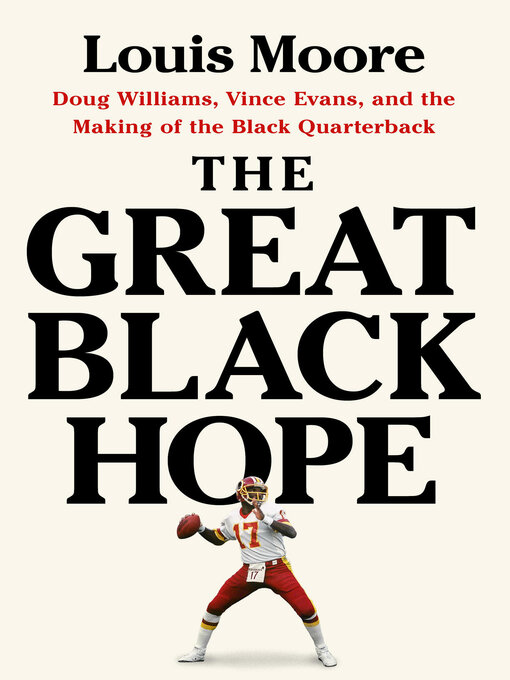The story of two pioneering Black NFL football players that changed the face of America’s game for generations to come.
There is no position in pro sports more important than an NFL quarterback. But quarterbacking was the exclusive domain of white players for many years, and when Doug Williams and Vince Evans arrived in the league in the late 1970s, they got death threats, faced racist questions, and knew that a single mistake could end their careers. The Great Black Hope tells the twin stories of Vince Evans,an electrifying dual-threat quarterback ahead of his time, and of Doug Williams, the first Black quarterback to become a champion. Moore shows how easily Williams' triumphant story could have gone wrong and how his success changed the game and the country.
A skillful blend of game-time drama and social commentary, this book captures unheralded heroes of the NFL and all that they meant, both on the field and off.
The Great Black Hope
Doug Williams, Vince Evans, and the Making of the Black Quarterback
-
Creators
-
Publisher
-
Release date
September 24, 2024 -
Formats
-
Kindle Book
-
OverDrive Read
- ISBN: 9781541705111
-
EPUB ebook
- ISBN: 9781541705111
- File size: 1200 KB
-
-
Languages
- English
-
Reviews
-
Publisher's Weekly
September 2, 2024
Moore (We Will Win the Day), a history professor at Michigan’s Grand Valley State University, provides a studious snapshot of the NFL’s prickly racial politics in the 1970s and ’80s. He focuses his account on Vince Evans of the Chicago Bears and Doug Williams of the Tampa Bay Buccaneers, who in 1979 became first Black quarterbacks to start an NFL game against each other. The son of educators, Evans enjoyed a comfortable middle-class childhood in Greensboro, N.C., before attending USC. Williams came from more humble means in Chaneyville, La., and played for Grambling State University. Moore emphasizes the stinging racism Evans and Williams faced in the pros, including having to contend with vitriol from white fans and doubts from coaches over whether Black quarterbacks were “smart enough to read a defense.” The Buccaneers won the matchup against the Bears and Williams would go on to lead the Washington Redskins to victory in Super Bowl XXII, while Evans was benched in favor of white quarterback Jim McMahon in 1983. The academic tone somewhat saps the excitement of the play-by-plays, but Moore makes a persuasive case that Williams and Evans expanded the notion of what was possible for Black athletes. It’s a winning examination of an overlooked milestone in football history. Agent: Jill Marr, Sandra Dijkstra Literary. -
Kirkus
September 1, 2024
A history of Black athletes who crossed the color line that kept them from playing quarterback. "Being a black quarterback," wrote aLos Angeles Times sports columnist, "is like being a member of the bomb squad." Make a mistake, in other words, andBoom! you're done. In 1979, an era in which, writes Moore, "it was still a foreign concept that Black men could be the field generals," two Black players set the field on fire: the Chicago Bears' Vince Evans, the fastest quarterback in the league, and T Doug Williams, a man with the best arm in the game but "the wrong paint job" who played for several teams before becoming a coach. They were the only two starters; before them, coaches rerouted Black players with quarterback skills to play as running backs, with the assumption that, regardless of speed and strength, Blacks lacked the intelligence to helm a team. Indeed, for decades "all the so-called thinking positions" in football were the province of white players only. When Williams and Evans faced off at Soldier Field on September 30, 1979, it was rightly seen as a historic moment. Moore looks back in time at the lineage of Black players who by rights should have preceded them (who knew that Jesse Jackson played quarterback for his HBCU?) and notes a few good-faith efforts in the mid-1970s, as when, for instance, Joe Gilliam started for the Steelers ahead of Terry Bradshaw. Discerning social critics pointed out that the question wasn't whether Black players were ready for the slot but whether football was ready for them. The answer came with Evans and Williams and then with their many successors, including Patrick Mahomes and Jalen Hurts who, astonishingly, as late as 2023 were the first Black QBs to face off in a Super Bowl. A piercing look at racial politics on the gridiron.COPYRIGHT(2024) Kirkus Reviews, ALL RIGHTS RESERVED.
-
Formats
- Kindle Book
- OverDrive Read
- EPUB ebook
subjects
Languages
- English
Loading
Why is availability limited?
×Availability can change throughout the month based on the library's budget. You can still place a hold on the title, and your hold will be automatically filled as soon as the title is available again.
The Kindle Book format for this title is not supported on:
×Read-along ebook
×The OverDrive Read format of this ebook has professional narration that plays while you read in your browser. Learn more here.


